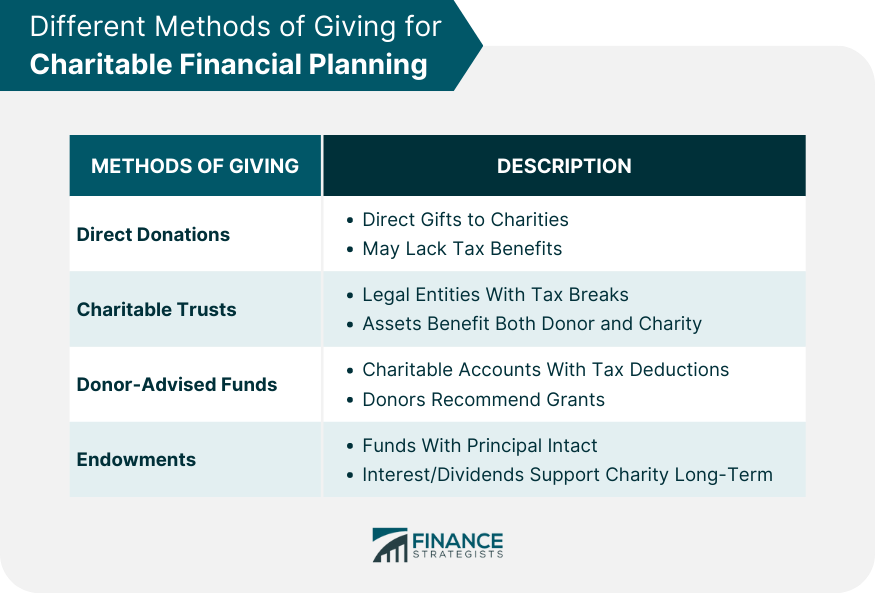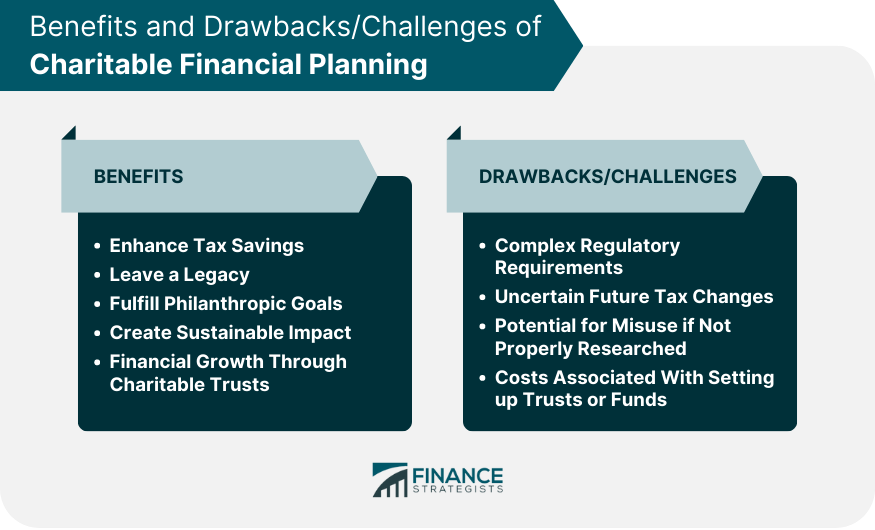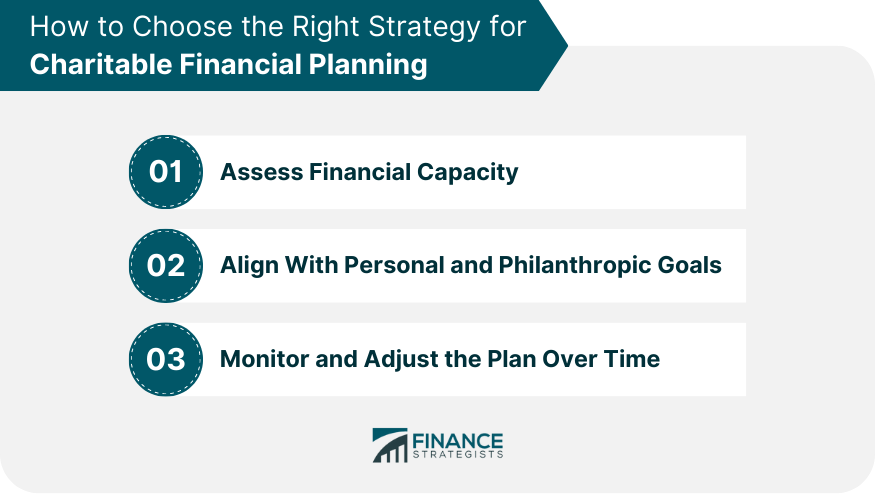Charitable financial planning is the act of deliberately setting out financial strategies tailored for philanthropy. Individuals or organizations structure their financial contributions to ensure both their financial and charitable objectives are met. This planning goes beyond sporadic donations. Instead, it's a calculated strategy that weaves together fiscal goals with charitable aspirations, optimizing the impact of every dollar given. A well-executed charitable financial plan has the duality of purpose—it serves as an extension of the donor's altruistic tendencies and as a tool for financial efficiency. Strategically distributed charitable donations not only bolster the recipient's cause but can also offer tax advantages and other fiscal benefits for the donor. Charitable financial planning melds personal values with fiscal prudence, allowing donors to magnify their impact. This strategy addresses global challenges like social inequalities and environmental issues by directing resources in a purposeful manner, fostering lasting change and a better world. Direct Donations: This is the simplest way to give. Donors directly provide funds or assets to a chosen charity. It's straightforward but may lack the tax benefits of more structured giving methods. Charitable Trusts: These are legal entities that hold and manage assets for charitable purposes. They can offer tax breaks and enable donors to benefit from the assets during their lifetime, with the remainder going to charity after. Donor-Advised Funds: These are accounts specifically for charitable purposes. Donors contribute to the fund and receive a tax deduction. Over time, donors can recommend grants from the fund to their chosen charities. Endowments: These are funds where the principal amount is kept intact, and only the interest or dividends are used for charitable purposes. They provide a long-term source of income for charitable causes. Deductions and Benefits: Charitable contributions can often be deducted from taxable income, reducing a donor's tax liability. The specifics of these deductions vary based on the donation method and regional tax laws. Gift Tax Considerations: Large gifts, even if given to charity, might trigger gift taxes. However, certain charitable donations can be exempt or have higher thresholds before the gift tax applies. Identifying Philanthropic Goals: Before embarking on a charitable journey, donors should outline their objectives. Are they passionate about education, health, or environmental causes? Defining this helps shape their charitable strategy. Choosing the Right Charities: Not all charities operate with the same efficiency or have the same impact. It's vital to research and select organizations that align with the donor's goals and have a proven track record. Collaborating With Financial Planners: Charitable giving can be complex, especially when tax implications are considered. Financial planners with expertise in philanthropy can guide donors, ensuring their giving is both impactful and fiscally sound. Philanthropy and fiscal prudence can coexist, especially when donors strategically structure their charitable contributions. Donations, when appropriately documented and itemized, can translate into notable deductions, trimming down the donor's taxable income. For instance, by donating appreciated assets like stocks, one can enjoy a deduction for the market value while bypassing capital gains taxes. Yet, the beauty of these tax benefits extends beyond just immediate savings. They can also influence future tax scenarios. For example, by integrating charitable giving into their estate plans, donors can potentially reduce future estate taxes, ensuring that more of their wealth is channeled according to their wishes. Charitable financial planning transcends the realm of money—it's about etching one's mark on the world. By setting up structured giving mechanisms, such as endowments or scholarships, donors can ensure their impact lingers long after they're gone. These legacies can serve as beacons, guiding future generations and echoing the values the donor held dear. Moreover, leaving a legacy isn't restricted to the uber-wealthy. Even modest endowments or funds, when managed correctly, can generate substantial long-term benefits. For the donor, it's a comforting thought, knowing that their contributions will continue to foster positive change, irrespective of their presence. Structured charitable financial planning empowers donors to realize their philanthropic dreams. Instead of ad-hoc contributions, donors, through meticulous planning, can ensure their resources are optimally allocated, amplifying their impact. When donations are aligned with clear objectives, they transition from mere financial aid to potent tools of change. In addition, this structured approach to giving offers something intangible yet invaluable—the profound satisfaction of seeing one's resources making a tangible difference. When donors witness their funds transforming lives, building communities, or driving research, their belief in the power of generosity is reaffirmed. Ad-hoc donations, while beneficial, might offer only temporary relief. In contrast, structured charitable financial planning aims for longevity, seeking to address issues at their core. Whether it's an endowment funding research year after year or a trust supporting a community initiative, planned giving ensures sustained impact. Such a long-term approach ensures that philanthropic endeavors don't just offer transient solutions. Instead, they lay down foundations for enduring change, creating ripples that can touch countless lives over extended periods. Charitable trusts like Charitable Remainder Trusts (CRTs) are unique amalgamations of philanthropy and financial planning. Donors place assets in these trusts, drawing income during their lifetime. Upon their demise, the remaining assets funnel to their chosen charity. It's a win-win—the trust assets can appreciate tax-free, potentially growing the fund for both the donor during their lifetime and the charity thereafter. Moreover, such trusts offer flexibility. They can be tailored to address specific financial situations or objectives, ensuring that donors don't compromise on their financial security while staying committed to their philanthropic aspirations. Philanthropy is a noble pursuit, but it's also one that's ensnared in intricate regulations. From establishing charitable trusts to the specifics of accepting gifts, the landscape is rife with rules. Navigating this maze requires due diligence and, often, expert guidance. A misstep could lead to legal repercussions, undermining the very essence of the charitable endeavor. And it's not just about setting up the right structures. Regular compliance, periodic filings, and ensuring all activities remain above board can be taxing. While the intent behind these regulations is to maintain transparency and protect stakeholders, they can sometimes be daunting for well-intentioned donors. The fiscal landscape is ever-evolving. Tax laws and policies, influenced by political, economic, and social dynamics, are prone to shifts. For someone deeply invested in charitable financial planning, such unpredictability can be unsettling. A strategy that's tax-efficient today might lose its luster tomorrow due to legislative changes. Therefore, it's imperative for donors to remain flexible. While they should leverage current tax benefits, they must also be prepared to pivot their strategies should the need arise. Regular consultations with tax and financial professionals can help donors stay agile in this dynamic environment. All charities aren't created equal. While many are genuinely committed to their causes, a few might lack transparency or efficiency. Hence, there's a latent risk of funds being misappropriated or not used optimally. Such scenarios can be disheartening for donors, watching their hard-earned money not achieving its intended purpose. To mitigate this risk, thorough research is paramount. Donors should delve into the operations, financial health, and governance of their chosen charities. Transparent organizations, those that regularly publish financial statements and impact reports, are typically more reliable. Due diligence ensures that philanthropy achieves its intended impact. Philanthropy might be about giving, but setting up structured charitable plans isn't free. Establishing trusts, endowments, or donor-advised funds often involves legal, administrative, and management fees. These costs, while necessary, can erode the funds meant for charitable activities. Before embarking on any structured charitable endeavor, it's wise to assess the associated costs. Donors should weigh these expenses against the long-term benefits and impact of their chosen strategy. Sometimes, simpler might be better, especially if administrative costs threaten to significantly dilute the funds earmarked for charity. Philanthropy, no matter how noble, should not jeopardize one's financial security. Hence, before carving out a charitable financial plan, individuals must take stock of their finances. This includes assessing assets, liabilities, existing commitments, and future financial needs. A balanced view ensures that while donors are generous, they don't overextend themselves. Post-assessment, donors can earmark funds for charity without compromising their financial well-being. This strategy ensures that their philanthropic endeavors are sustainable over the long run, benefiting both the donor and the recipient. Charitable financial planning is deeply personal. It's a manifestation of one's values, beliefs, and aspirations. Hence, it's essential to introspect and crystallize one's philanthropic objectives. Whether driven by personal experiences or broader societal issues, the chosen strategy should resonate with the donor's core beliefs. Once these goals are clear, they act as a compass, guiding all charitable endeavors. They dictate the choice of charities, the method of giving, and even the scale of contributions. By ensuring alignment between personal values and philanthropic objectives, donors can derive immense satisfaction from their giving, knowing it's a true reflection of their ethos. No plan, no matter how well-conceived, is static. The realms of finance and philanthropy are dynamic, influenced by a myriad of factors ranging from economic conditions to evolving personal preferences. Consequently, charitable financial plans need regular revisits and recalibrations. Regular reviews ensure that the strategy remains in sync with the donor's objectives and the external environment. Adjustments might involve switching charities, altering the donation quantum, or even changing the method of giving. Such agility ensures that the donor's philanthropic journey remains impactful and fulfilling, irrespective of the external dynamics. Charitable financial planning is a structured approach to philanthropy, intertwining fiscal goals with altruistic aspirations for optimal impact. Beyond sporadic contributions, this strategy meticulously weaves donors' financial and charitable objectives, potentially offering tax benefits and ensuring the effective use of resources. Different methods like direct donations, charitable trusts, donor-advised funds, and endowments provide varied ways to give. While such planning boasts numerous benefits, including enhanced tax savings, legacy creation, fulfillment of philanthropic goals, and sustainable impact, challenges persist. Complex regulatory requirements, potential tax law changes, and the risk of charity misuse underscore the need for diligent research and flexibility. Additionally, the costs of setting up structured plans can't be overlooked. For successful charitable financial planning, individuals must assess their financial capacity, align with personal philanthropic goals, and continuously monitor and adapt their plans, reflecting changing personal and external factors.What Is Charitable Financial Planning?
How Charitable Financial Planning Works
Different Methods of Giving

Tax Implications
Setting up a Charitable Plan
Benefits of Charitable Financial Planning
Enhance Tax Savings
Leave a Legacy
Fulfill Philanthropic Goals
Create Sustainable Impact
Financial Growth Through Charitable Trusts
Drawbacks/Challenges of Charitable Financial Planning
Complex Regulatory Requirements
Uncertain Future Tax Changes
Potential for Misuse if Not Properly Researched
Costs Associated With Setting Up Trusts or Funds

How to Choose the Right Strategy for Charitable Financial Planning
Assess Financial Capacity
Align With Personal and Philanthropic Goals
Monitor and Adjust the Plan Over Time

Bottom Line
Charitable Financial Planning FAQs
Charitable financial planning is a tailored strategy that combines fiscal goals with charitable aspirations, optimizing every dollar given for impact and financial benefits.
Charitable financial planning, when executed thoughtfully, can lead to valuable tax deductions, reducing taxable income and potentially offering estate tax advantages.
Yes, challenges include navigating complex regulatory requirements, the potential for misuse of funds if not researched, and adjusting to future tax changes.
It involves assessing your financial capacity, ensuring alignment with your personal and philanthropic goals, and periodically monitoring and adjusting your plan.
Methods include direct donations, charitable trusts, donor-advised funds, and endowments, each with unique benefits and considerations.
True Tamplin is a published author, public speaker, CEO of UpDigital, and founder of Finance Strategists.
True is a Certified Educator in Personal Finance (CEPF®), author of The Handy Financial Ratios Guide, a member of the Society for Advancing Business Editing and Writing, contributes to his financial education site, Finance Strategists, and has spoken to various financial communities such as the CFA Institute, as well as university students like his Alma mater, Biola University, where he received a bachelor of science in business and data analytics.
To learn more about True, visit his personal website or view his author profiles on Amazon, Nasdaq and Forbes.











